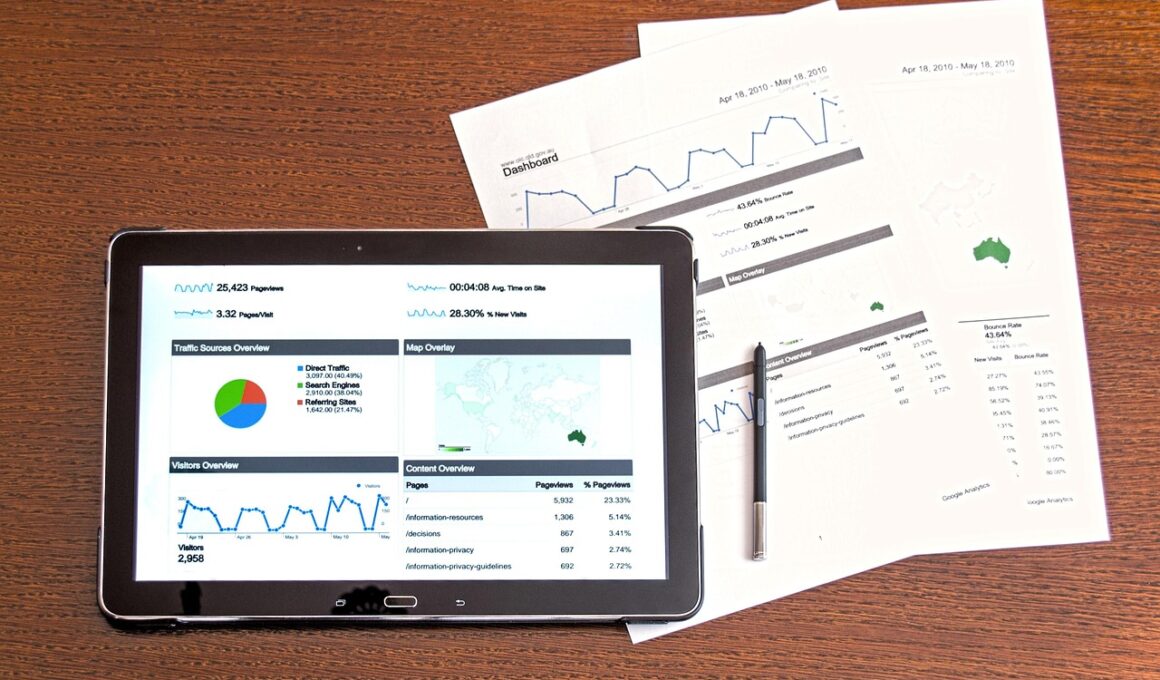Using Analytics to Drive B2B Email Marketing Decisions
In today’s competitive B2B landscape, utilizing analytics is essential for optimizing email marketing campaigns. Analytics delivers insights into customer behavior, preferences, and engagement, empowering marketers to make data-driven decisions. Understanding key metrics like open rates, click-through rates, and conversion rates allows for better targeting. Analytical tools help assess the effectiveness of various subject lines and email content types. By leveraging data, businesses can tailor their campaigns to meet the specific needs of their audience. For example, segmenting email lists based on user demographics and engagement history improves campaign relevance. A/B testing various approaches provides valuable feedback, leading to continuous improvements. In addition to engagement metrics, monitoring unsubscribe rates offers insights. High unsubscribe rates may indicate misalignment with audience expectations or content quality. Therefore, a detailed review of customer feedback can provide further insights into audience preferences. Integrating analytics into B2B email marketing strategies creates informed approaches that resonate with potential clients, ensuring marketing efforts are both impactful and efficient. Ultimately, analytics empowers marketers to refine their strategies, enhancing overall campaign effectiveness and driving success in email marketing.
Understanding the customer journey is crucial for developing targeted email marketing campaigns. Analytics tools can track how prospects interact with your emails and website. This data highlights the specific touchpoints that lead to conversions, enabling businesses to reinforce these positive experiences in future campaigns. Additionally, knowing where prospects drop off in the customer journey allows for optimization, tailoring follow-up emails that encourage engagement. Utilizing behavioral data also plays a role in personalizing communication. By sending relevant content aligned with prospects’ interests, companies can foster better relationships and increase conversion rates. Customer personas build a clearer picture of ideal clients and refine email messaging accordingly. Furthermore, analyzing past campaign performance assists in predicting future success metrics. As you gather more data, trends can emerge based on past successes and failures. Identifying patterns ensures that your future campaigns are more likely to resonate with your audience. Additionally, keeping software and tools up-to-date guarantees access to the latest analytics features. Consistent analysis and adjustment cultivate email marketing campaigns that evolve alongside customer preferences, ultimately driving heightened engagement and revenues over time.
The Importance of A/B Testing in Email Campaigns
A/B testing is a vital component in optimizing B2B email marketing strategies. This method involves comparing two versions of an email to determine which one performs better. Different elements, such as subject lines, email designs, and calls to action, can be tested against one another. By carefully analyzing the performance of each email variant, marketers gain invaluable insights into audience preferences. A/B testing helps determine optimal sending times, assisting in maximizing open rates. Implementing A/B testing promotes a culture of continuous improvement and refines email campaigns. Regularly testing various elements means that marketing strategies can adapt based on current data trends. Additionally, gauging audience reactions helps to identify which message formats resonate best, ensuring that communications remain engaging over time. However, it’s important to maintain a strategic approach—testing one element at a time can prevent confounding results. Analytic tools seamlessly integrate A/B testing results to inform broader marketing strategies. In the grand scheme of things, the actionable insights gained from A/B testing lead to enhanced engagement and increased conversions across email campaigns.
Another critical factor impacting B2B email marketing is audience segmentation. Effective segmentation allows marketers to send tailored messages to specific groups of recipients, enhancing relevance and engagement. Utilizing data analytics, businesses can define segments based on various criteria, including demographics, past purchase behavior, and engagement levels. For instance, sending targeted content to previous buyers can boost repeat purchases. By analyzing past interactions and preferences, marketers can generate tailored email content that speaks directly to their audience’s interests. Trading generic messaging for personalized emails significantly improves open and click-through rates. Moreover, segmentation helps identify dormant leads, allowing marketers to create re-engagement strategies. Various campaigns could include special offers or informative content that emphasizes value. Furthermore, continuous review of segment performance ensures that targeting remains efficient. Metrics collected can highlight which segments respond best to certain campaigns, improving future targeting decisions. Analyzing segmentation outcomes enables businesses to shift marketing strategies when necessary. Consequently, using analytics-driven audience segmentation consistently cultivates stronger connections with clients, promoting loyalty while enhancing ultimate conversion rates within email marketing initiatives.
Analyzing Customer Feedback for Continuous Improvement
Customer feedback plays a crucial role in refining email marketing efforts. Analyzing responses from audience surveys, engagement metrics, and direct replies provide insight into recipients’ perceptions. Encouraging clients to share their thoughts demonstrates a commitment to genuine relationships. When feedback points to common themes of dissatisfaction, changes can be made to rectify issues. Likewise, positive feedback should also guide future content creation, celebrating aspects that resonate well with recipients. Implementing feedback-driven improvements not only enhances engagement but builds loyalty within your audience. Furthermore, leveraging advanced analytics technologies aids in understanding customer sentiment. Tools designed to evaluate customer interactions can gauge overall satisfaction levels. By utilizing sentiment analysis, organizations identify areas that require focus. Regularly reviewing performance reports allows for timely adjustments, ensuring campaigns evolve alongside customer expectations. Monitoring feedback should not be a one-time task but an ongoing commitment. Consistent evaluation ensures that your email marketing strategies remain relevant and appealing to your audience. By fostering a culture that values feedback, businesses can drive continuous improvement within email marketing campaigns, ultimately leading to increased success.
Integration of CRM systems with email marketing analytics is invaluable for enhancing efforts. Aligning customer relationship management systems with email campaigns creates a comprehensive view of customer interactions. This data consolidation enables marketers to explore rich insights from various touchpoints. Combining data allows businesses to track campaign performance and identify key sales opportunities simultaneously. Additionally, synced data creates a seamless experience for both marketers and customers. For instance, real-time notifications about customer behavior can trigger timely follow-ups to engage potential clients. Furthermore, analyzing merged data shapes better-targeted marketing efforts, increasing the likelihood of conversions. As customer expectations evolve, maintaining a current understanding of audience needs becomes vital. Integrating CRM analytics can fine-tune segmentation strategies, ensuring tailored messaging reaches the right audience. Not only does integration enhance campaign precision, but it also fosters efficient use of resources. Fine-tuning analytical tools guarantees optimal alignment with broader marketing goals. Companies that prioritize integrated systems are often better positioned to engage successfully with current and potential clients, thus driving more meaningful interactions. Ultimately, synchronization across platforms promotes a well-orchestrated approach towards mixed marketing strategies.
Conclusion: Driving Effective Email Marketing with Analytics
Successfully driving B2B email marketing decisions hinges on analytics and insights. Diligently analyzing customer behaviors and preferences paves the way for more effective communication strategies. By harnessing the power of analytics, businesses can make informed decisions that enhance overall marketing outcomes. Tailoring content and segmenting audiences lead to heightened engagement metrics, especially in complex B2B landscapes. Moreover, integrating feedback and A/B testing empowers marketers to continually adapt campaigns based on audience preferences. Windows into customer journey experiences allow for closer relationships between businesses and clients, fostering loyalty. Continuous evaluation and refinement ensure that marketing strategies must be in tune with consumer sentiments and preferences as they evolve. Furthermore, effective integration with CRM systems serves as the backbone for situational responses to customer demands. Embracing analytics as a guide means that businesses can confidently navigate the intricacies of email marketing. Ultimately, pursuing data-driven methodology creates valuable connections and robust marketing performance in an ever-changing environment. Strong analytical foundations will provide the tools required to measure success effectively and achieve long-term growth within B2B email marketing endeavors.
In conclusion, taking strategic actions toward collaborative decision-making processes creates lasting changes. When employing analytical data effectively, marketers can prioritize their campaigns based on what leads to success. Organizations that understand the value of analytics in driving decisions stand to experience significant advantages over competitors. They can optimize their email marketing efforts, not only enhancing performance but also delivering individualized experiences to audiences who resonate with the brand’s messaging. Ultimately, as businesses leverage analytics for continuous improvement, they can build lasting relationships that cultivate trust and loyalty, making a meaningful impact in the B2B marketing arena. Utilizing analytics as a compass signifies the evolution of email marketing strategies, ultimately empowering marketers. A commitment to data-driven decision-making sets marketing departments apart, unlocking opportunities for better alignment with audience needs. As companies embrace technological advancements within the realm of marketing, staying updated with industry best practices is essential. Every analytical insight gained strengthens the decision-making process, leading to further refinement of campaigns. Emphasizing metrics creates a foundation for effective B2B email marketing, allowing businesses to navigate complex landscapes effectively.


